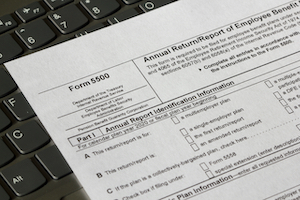ERISA consultants at the Retirement Learning Center Resource Desk regularly receive calls from financial advisors on a broad array of technical topics related to IRAs, qualified retirement plans and other types of retirement savings and income plans, including nonqualified plans, stock options, and Social Security and Medicare. We bring Case of the Week to you to highlight the most relevant topics affecting your business.
 A recent call with an advisor in Colorado is representative of a common inquiry regarding Form 5500 filing rules for defined contribution plans. The advisor asked, “I attended a conference where there seemed to be a great deal of confusion regarding the Department of Labor’s (DOL’s) newly released Form 5500 filing rules. One change relates to how plans count participants for the independent audit requirement. Can you clarify, please?”
A recent call with an advisor in Colorado is representative of a common inquiry regarding Form 5500 filing rules for defined contribution plans. The advisor asked, “I attended a conference where there seemed to be a great deal of confusion regarding the Department of Labor’s (DOL’s) newly released Form 5500 filing rules. One change relates to how plans count participants for the independent audit requirement. Can you clarify, please?”
Highlights of Discussion
Perhaps the most important detail about the new Form 5500 filing rules is that they pertain to the 2023 plan year filing, which will be done in 2024. Plan sponsors must follow the current rules for the 2022 plan year filing.
The DOL requires sponsors of employee benefit plans subject to the annual Form 5500 series of returns and schedules to include an audit report from an independent qualified public accountant (IQPA). There is an exception to this requirement for “small plans” (i.e., those with fewer than 100 participants at the beginning of the plan year) (DOL Reg. 2520.104-46). The current rules count individuals who are eligible to participate even if they have not elected to participate and do not have an account in the plan.
For plan years beginning on or after Jan. 1, 2023, participant count for the audit waiver will be based on the number of participants with account balances at the beginning of the plan year. This change is intended to reduce the number of plans that need to have an audit, lower expenses for small plans and encourage more small employers to offer workplace retirement savings plans to their employees.
For both 2022 and 2023, a plan may qualify for the audit waiver even if there are more than 100 participants. Under the “80 to 120 Participant Rule,” if the number of participants covered under the plan as of the beginning of the plan year is between 80 and 120, and a small plan annual report was filed for the prior year, the plan administrator may elect to continue to file as a small plan and, therefore, qualify for the audit waiver.
For more information, please see the final regulations for Annual Reporting and Disclosure.
Conclusion
The Form 5500 filing regulations, among other things, change the method of counting participants for purposes of determining when a defined contribution plan must file as a small plan, which also factors into whether the plan may be exempt from the IQPA audit requirement. Specifically, for 2023 and later plan years, plans are directed to count only the number of participants/beneficiaries with account balances as of the beginning of the plan year, as compared to the current rule that counts all the employees eligible to participate in the plan.
Any information provided is for informational purposes only. It cannot be used for the purposes of avoiding penalties and taxes. Consumers should consult with their tax advisor or attorney regarding their specific situation.
©2023, Retirement Learning Center, LLC. Used with permission.

